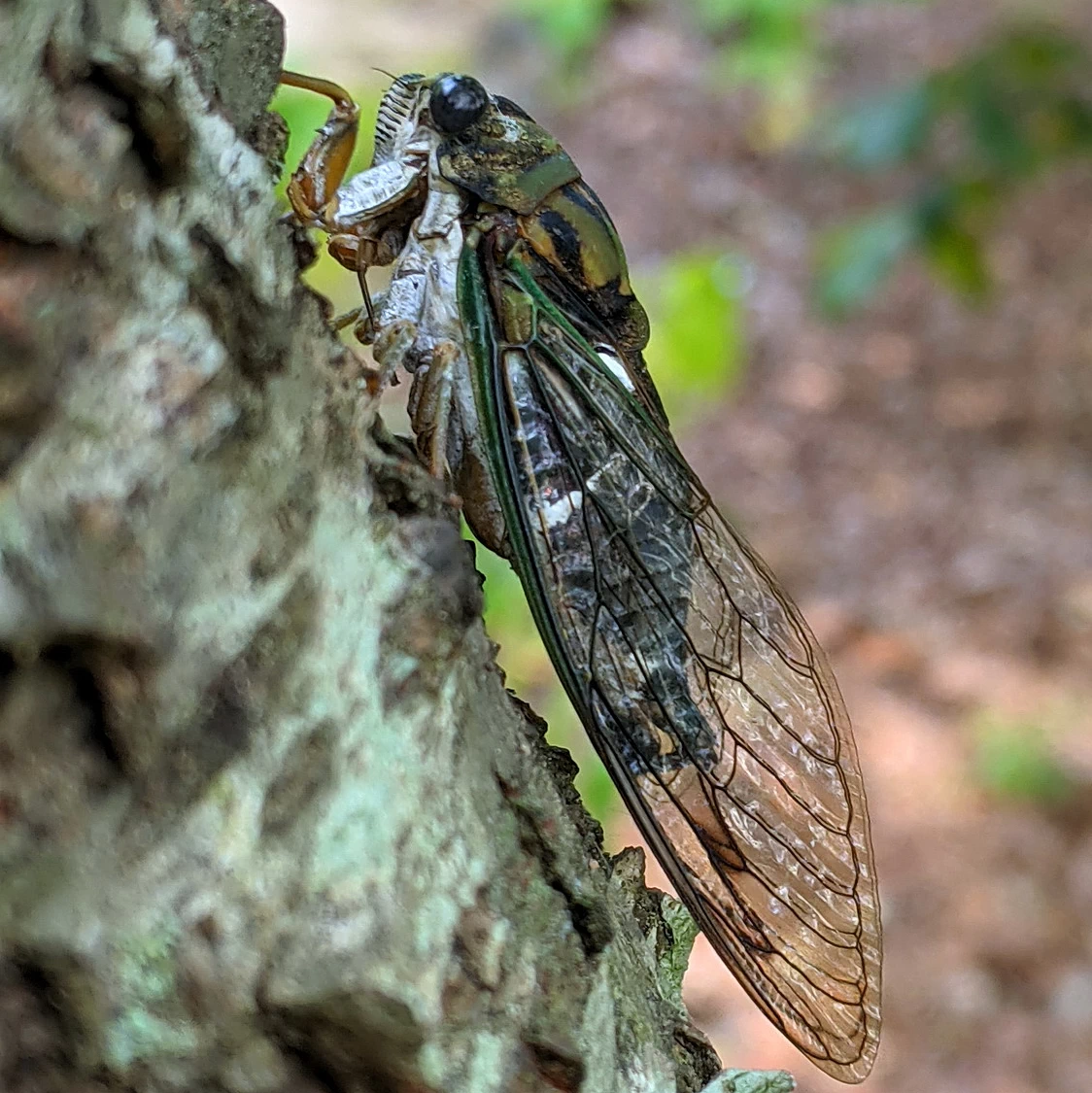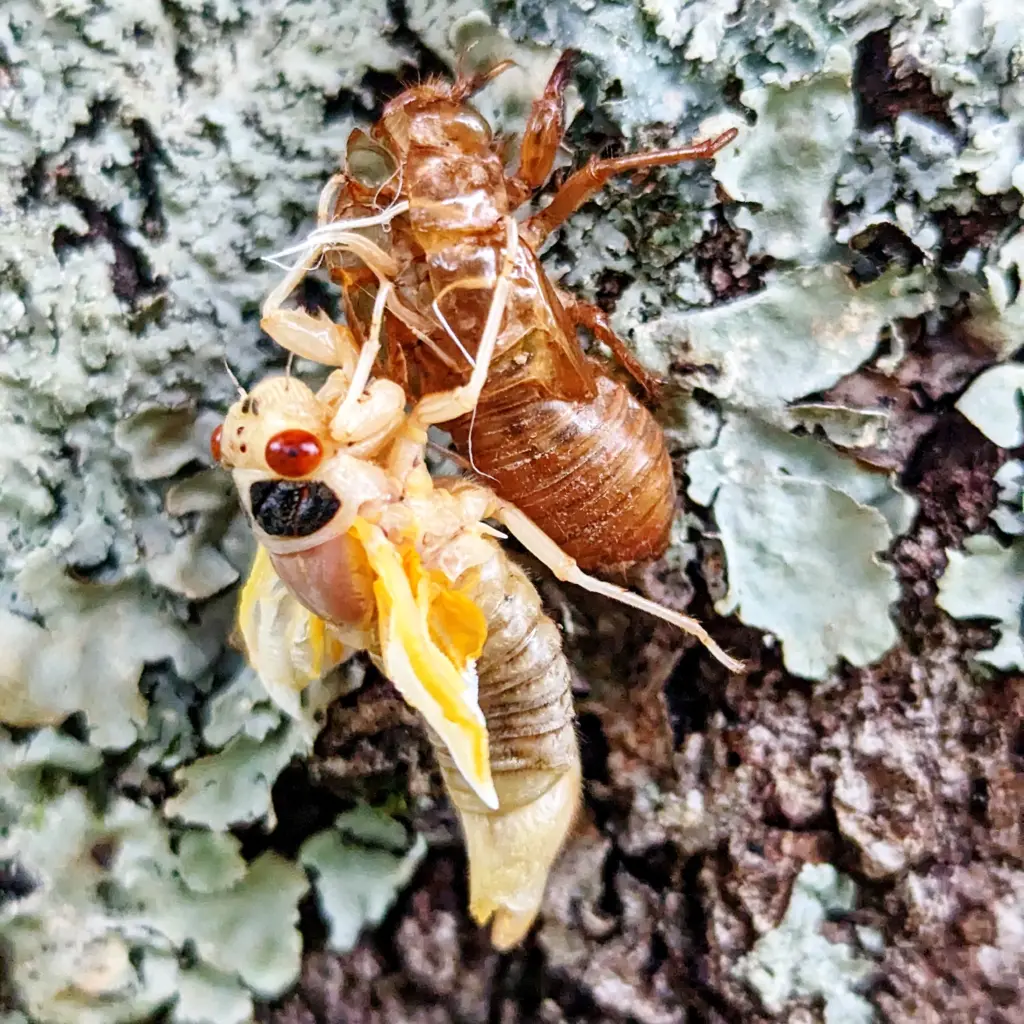

Each afternoon in recent weeks, Theresa and I have sat outside on our deck and marveled at the loud, pulsating sounds made by thousands of cicadas high in the trees on our Alexander property. Some folks know these big insects as “locusts,” but they are properly called “cicadas.” They sing their weird love songs and leave behind weird-looking shells when they shed their skins.
When hot weather arrives, male cicadas begin making their familiar mating calls. Dog-day cicadas do this every year, but smaller species called periodical cicadas appear here only once every 13 years. These emerge in unbelievable numbers and make an astounding noise. An article in the Arkansas Gazette reported them on May 25, 1855, with a note that some people believed them to be an omen of war because “they have red eyes, and the letter W (for war) on their wings.”
In 2024, Arkansas has experienced a rare and remarkable event: a double emergence of cicadas, specifically the 13-year Brood XIX and the 17-year Brood XIII, coinciding for the first time in over 200 years. This phenomenon has brought billions, perhaps trillions, of cicadas out of the ground in many areas the state, providing an unprecedented opportunity to observe and listen to these incredible insects.
Male cicadas make sounds to attract nearby females, which respond by snapping their wings. The male hears this and responds by moving closer.

A few years ago, researchers learned that as the male cicadas approach the females, their sound gets softer. One of them described this as the cicada putting on its best bedroom voice and uttering the insect equivalent of “Hey, baby.”
In field experiments, the researchers showed that they could trick the male cicadas by making a snapping sound that mimics the females. When mating is complete, the cicadas are done—the males anyway. Females live long enough to lay up to 600 eggs in the branches of trees before they die. When the nymphs hatch, they fall to the ground and burrow underground until they find a fat, tasty root to suck on. They remain there until it’s time for their brood to emerge and start the cycle all over again.
On some days in July and August, particularly during those years like 2024 when a brood of periodical cicadas emerges, the droning of male cicadas in the trees can be almost overwhelming. The loudest cicadas can emit sounds exceeding 100 decibels. These can be heard over a mile and a half away.
How can a 2-inch-long animal can make such a loud sound? With no vocal chords, no lungs and no loudspeaker, it ought to be impossible to hear a cicada so far, yet it is not.
Cicadas make sounds not by rubbing together their wings or legs, as some people think, but by using special sound-producing organs called tymbals. Each male cicada has two of these ribbed membranes, one on each side of its abdomen.
The complex manner in which the cicadas’ tymbals produce sound can be difficult to understand, but Kyle Schiber, writing for the Chicago Academy of Science blog, explained it quite simply.
“The tymbal contains a series of ribs that buckle one after the other when the cicada flexes its muscles,” he said. “Every time a rib buckles, the rib produces a click. Many clicks produce a buzzing sound. The action is like how a bendy straw makes sound: pulling and pushing the ribs of the bendy straw together makes a series of clicks. If you could push, pull and twist a bendy straw hundreds of times a second, the sound of the clicks would be so close together that you’d only hear a buzzing sound. This is how fast the cicada is able to vibrate its tymbals.”

While that paragraph clearly describes the basic mechanism of the cicadas’ sound-producing tymbals, researchers face a daunting challenge when trying to reproduce the sound. Having the cicadas’ ability to make an extremely loud noise with a very small body using very little power could be useful in many ways. For example, scientists at the Naval Undersea Warfare Center in Newport, Rhode Island believe reproducing the cicadas’ sound would be the first step toward making devices that would mimic it for remote sensing underwater, ship-to-ship communications, rescue operations and other applications. But the lead researcher on that project, Derke Hughes, says his team has not yet worked out an accurate physics-based model that replicates the manner through which the cicadas make their sounds.
“We’re still working on it,” he said.
While Hughes and other scientists continue looking at ways humankind can benefit from cicada songs, people like me who consider cicada sounds as soothing as a lullaby can enjoy sitting in the shade of a tree on a warm summer day and listening to the rhythmic sound of countless cicadas thrumming overhead. For many of us, that uniquely southern sound brings back memories of youthful days collecting cicada shells with friends.

Keith “Catfish” Sutton of Alexander, Arkansas, is one of the country’s best-known outdoor
journalists. His stories and photographs about fishing, hunting, wildlife and conservation have
been read by millions in hundreds of books, magazines, newspapers and websites. He and his
wife Theresa own C&C Outdoor Productions Inc., an Arkansas-based writing, photography,
lecturing and editorial service.




Get DownHome Arkansas blog posts, news, and more directly by email. Give us your name and email if you’d like to subscribe.